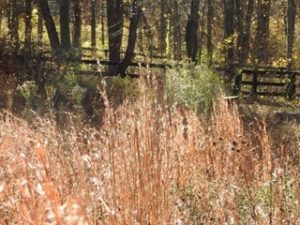Vol. 21 Issue 4, Winter 2016
By Ann Garvey, Audubon At Home Ambassador

photo by Ann Garvey
Ever wonder what that beautiful golden grass is in the field or your neighbor’s meadow lending some interest and color to the winter? It is broomsedge (Andropogon virginicus). Despite its name, it is not a sedge – it is a warm season bunch grass.
Broomsedge seems to appear out of nowhere in our meadows and fields in September with its dense erect stems of orange-red and its silver hairs. Perhaps you are in need of a broom? The pioneers used broomsedge for making brooms. Stripping it down to just the stems and tying a large group of them together they were able to clean the hearth and floors.
Although the seeds of broomsedge are generally dispersed by wind in the winter, one can observe Dark-eyed Juncos, Chipping Sparrows or Field Sparrows perched on its stalks plucking away feathery seed wings to eat the half-inch long fruits. Deer and white-footed mice enjoy munching on the grass. Turkeys, as well as quail, like the cover it affords their nests.
This grass can grow up to five-feet tall and it grows well on low-fertility eroded soils. It is good grass to help with erosion control. It is also useful in rain gardens, storm water management areas, water-wise landscapes, as well as a pioneer species in native meadows, roadside and restoration projects. It is allelopathic towards some plants in that it releases a biochemical which suppresses the growth of other plants in the field. It can take over an area in four to five years but is generally short-lived.

